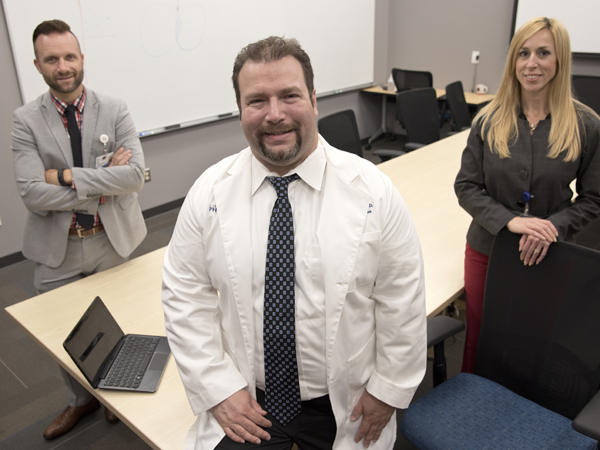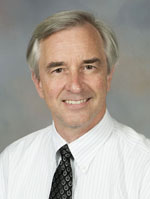Predicting a patient’s health path

You're a University of Mississippi Medical Center heart patient, and your care is tailored to a mathematical analysis showing that in a grouping of 10 patients with your symptoms, seven are predicted to have a heart attack over the next year - and you are in that seven.
It's just one example of predictive analytics, a method of crunching data that only in recent years has become an effective tool in the health-care arena for forecasting and treating diseases.
Leading that effort at the Medical Center is Dr. John Showalter, assistant professor in the School of Medicine and UMMC chief health information officer. He's a trailblazer in predictive analytics and began delving into that electronic health-care tool a decade ago.
He and his six-member team in the new Center for Informatics and Analytics hope to finish validating data gathered via analytics from UMMC patients so that by this fall, it can be used for creating individualized treatment plans.
"We're using a lot of data - things like a patient's vital signs, lab results, whether or not they smoke, what medications they're on, and how close they live to a pharmacy - to identify their health risks," Showalter said. "It's a mathematical approach to identifying health risks, and ideally, at the patient level."
Showalter's innovative use of predictive analytics has garnered plenty of national attention. He's among a handful of recipients named an Analytics All-Star by the magazine Health Data Management, which recognizes organizations and individuals creatively using analytics to improve the health of their patients and by doing so, helping the financial performance of their organizations.
In naming Showalter its All-Star Clinical Visionary, the magazine wrote: "Showalter is a force behind UMMC's effort to address heart disease in Mississippi using clinical predictive analytics.
"Using the predictive insights, UMMC is able to identify high-risk patients and to provide interventions in a tactical, efficient and effective way," the magazine said.
Much of Showalter's efforts have been concentrated in achieving better health outcomes for patients suffering from heart disease, a leading cause of death in Mississippi. He and his team are working with the predictive analytics company Jvion to take in hand their clinical data and use it to predict which individuals are at the highest risk of heart attack. "They are combining that data with environmental factors that are based on that patient's zip code," Showalter said.
Just as a lab test involves analyzing blood, Showalter said, "predictive analytics is an analysis of your electronic health record data. The results come back, just like they do on a blood test, and it will figure into clinical decision-making."

Dr. Thomas Skelton, a cardiologist and professor in the School of Medicine, said Showalter's work with "big data" will help physicians "learn about the tendencies of the population, and figure out how to best handle them.
"The idea is that you gather data, and not all data is a traditional medical record," Skelton said. "For example, what are the highways like for someone in rural Holmes County? Do transportation or dilapidated bridges have anything to do with how they seek medical care?"
Gathering a variety of data and entering it into a patient's electronic health record can give physicians a glimpse of a patient's lifestyle and environment that might not surface at a doctor's appointment, he said. "I don't ask patients how far away their nearest pharmacy is, but if I knew the nearest pharmacy was 60 miles away, that would be part of our discussion," Skelton said.
Whether a patient has a phone also could be a critical part of his electronic medical data, Skelton said. "If having a telephone and answering it on a regular basis when nurses call is a big part of keeping those patients out of the hospital, then that suddenly becomes a medical risk factor," he said.
Mississippi's geography, he said, can be a special challenge for heart patients who find themselves needing urgent care. That makes knowing their environmental and medical risk factors that much more important, Skelton said.
What's especially exciting for the clinical arena is Showalter's use of analytics to take the Medical Center's entire population of heart patients and narrow it to the 1.5 percent most at risk of having a heart attack over the next 12 months. His team then took it a step further, identifying from that 1.5 percent 75 of 100 patients who are predicted to actually suffer a heart attack within 12 months or less.
"We have a number of other areas we are looking at, such as hospital acquired conditions and specifically pressure ulcers, but I do expect the Center will partner with physicians to look at their individual patients," Showalter said. "We do this at the population level, but then get as specific to the patient as possible."
Predictive analytics can be "remarkably precise," Showalter said. But achieving the final validation of data "is frustratingly slow. Waiting can be very stressful. What we're doing now is running surveillance on all of our inpatients, and we've already run it on 10,000 patients. We will do 25,000 patients before the end of the year.
"We're validating predictions in real time while we are trying to figure out why patients are high risk and what interventions we can do for them."
Showalter believes the magazine recognized his work because "we are the only place I know of that is sending electronic health record data to be analyzed, and then putting that back into the health record," he said. "We are definitely ahead of the game at UMMC."
"That's what big data is all about: Not necessarily predicting the future, but finding out the trends and tendencies of patients, both as a population of similar patients and as individuals, so that we can develop health-care systems that accommodate those behaviors," Skelton said.
Between now and when his team finishes validating data, Showalter said, risks to patients can still be identified and acted upon. "There are some very obvious things - for example, if they are smoking, getting them to quit. We can also help get their diabetes under control," he said.
"This is about identifying that group of 10 where seven are at risk, and doing everything we can to make their chronic disease improve. We need to go the extra mile for that population."


